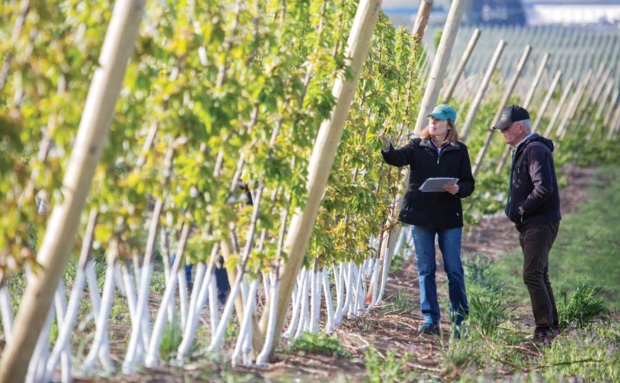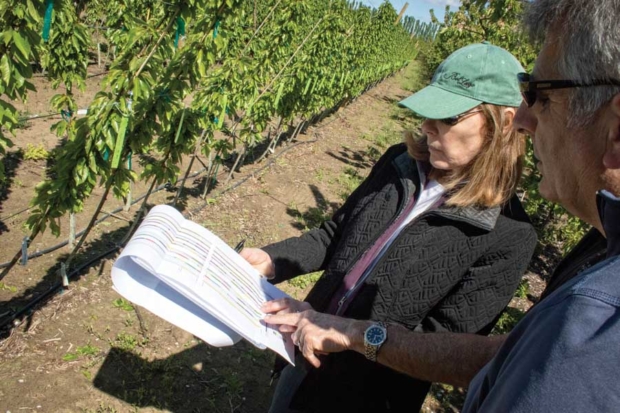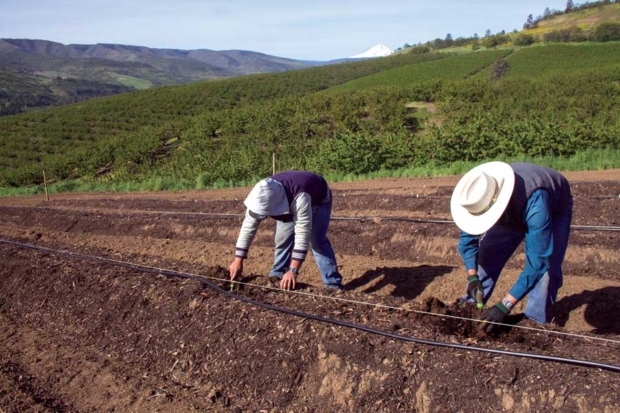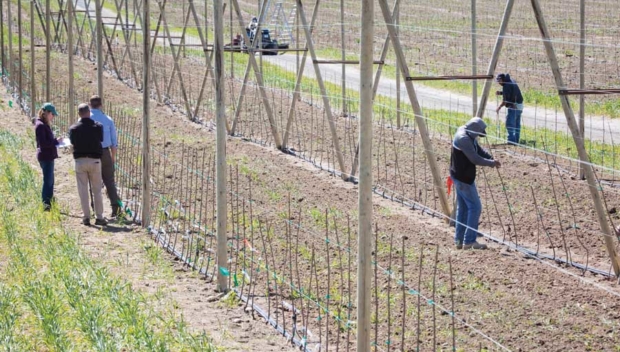
Michigan State University researcher and tree fruit breeder Amy Iezzoni, left, and Tom Auvil of the Washington Tree Fruit Research Commission, visit a cherry dwarfing rootstock trial in central Washington on April 15, 2016. (TJ Mullinax/Good Fruit Grower)
When it comes to dwarfing and precocious rootstocks, the greatest impact on commercial production has come in the apple industry, with research to develop new cultivars going back nearly 40 years in the United States.
For sweet cherries, interest — and current cultivars like Gisela and Krymsk — came later, though growers continue to seek rootstocks that will produce high volumes of high-quality fruit on labor-friendly dwarfing trees.
Michigan State University’s cherry rootstock program has been working to improve efficiency and reliability of such finished tree propagation, while aiming to improve virus sensitivity, among other things.
The project is seeing some results, and it’s growing in planted plots and data, with additional plantings planned in the Pacific Northwest.
MSU is pursuing patents for these cherry rootstocks, as several West Coast nurseries have plant material ready for propagation. Meanwhile, researchers are examining how each rootstock performs with different cultivars and in different training systems, soils and growing conditions.
Five rootstocks are of key interest — Crawford, Lake, Clinton, Cass and Clare, all named after Michigan counties.

The trial includes a variety of rootstocks — including Cass and Lake — at sites in Washington and Oregon. These trials above are in The Dalles, Oregon on April 16, 2016. (Shannon Dininny/Good Fruit Grower)
The project, led by MSU researcher Dr. Amy Iezzoni, has the support of the Washington Tree Fruit Research Commission, the Oregon Sweet Cherry Commission and the Michigan Cherry Committee, which also has provided support to develop Armillaria resistant rootstocks as part of her work.
Iezzoni visited the Pacific Northwest in April to examine the plots in Wenatchee and Mattawa, Washington, and The Dalles, Oregon, and gather data with cooperating researchers. Following a six-year trial at Washington State University in Prosser, Washington, additional trials were planted in 2015.
Four of the rootstocks are in their second leaf, with the fifth, Crawford, planned for planting next spring. Scions are Regina, Early Robin and Sweetheart. Control rootstocks, which varied by site, were Gisela 5 and 6 and Krymsk 5 and 6.
Washington sites
At McDougall and Sons’ Legacy Orchard east of Wenatchee, Washington, the training system is a super slender axe in an angle canopy trellis, with 12 feet between rows.
Spacing between trees varies by rootstock — 2 feet for Clinton, 1 foot for Cass, Lake and Clare — with a range of 1,800 to 3,600 trees per acre.
The result is the large rootstocks are 4 feet apart under each arm of the trellis, and the more dwarfing are 2 feet apart under each arm of the trellis. The orchard has drip irrigation with fertigation.
The trees’ outer bark was girdled at 10- to 12-inch intervals and some individual buds notched just above the buds by Dr. Stefano Musacchi, Washington State University pomologist.
Following the gentle girdling, there were four Promalin (benzyladenine and gibberellic acid) treatments timed to precede warm weather (over 70 degrees Fahrenheit). Iezzoni noted the impressive bud breaks that were occurring as a result of the girdling and Promalin treatments.
The target was for trees to be hitting the top trellis wire, around 11 feet from ground level, by the second leaf, Musacchi said, and that was happening almost everywhere in the orchard.

Michigan State’s Amy Iezzoni at one of the established sites in Washington near Mattawa, Wash., on April 15, 2016. (TJ Mullinax/Good Fruit Grower)
At a Washington Fruit and Produce Co. orchard in Mattawa, Washington, trees were planted on a four-wire trellis, super slender axe V system, with the spacing between trees under each arm of the trellis at 3 feet for the large trees (Gisela 6, Krymsk 5), 18 inches for the dwarfs (Clare, Cass, Lake) and 2 feet for the intermediate vigor trees (Clinton, Gisela 5), with 12 feet between rows. For spacing down the row, the equivalent would be: 1.5 feet, 9 inches and 1 foot.
Key to this site is the soil, which is very sandy, but Iezzoni noted the trees’ growth. “It’s wonderful to see them growing with such vigor; and once again, with the girdling, they’re getting all these breaks,” she said. “The challenge in Mattawa is to keep that break growing in the light soils.”
In the 2009 Prosser Bing trial, Clare had fewer flowers per cluster than Gisela 5 or 6. The flower clusters on Kyrmsk 5 and 6, Lake, Clare and Cass had better distribution and less bunching than the Gisela rootstocks.
The Dalles

Michigan State University researcher and tree fruit breeder, Amy Iezzoni, visits several of her cherry dwarfing rootstock trials in The Dalles, Oregon on April 16, 2016. (Shannon Dininny/Good Fruit Grower)
Tim Dahle’s orchard in The Dalles, Oregon, features a central leader system for Regina and a KGB system for Early Robin and Sweetheart, with 16 feet between rows and 8 feet between trees, at about 340 trees per acre. The trees are irrigated by microsprinklers.
Lynn Long, Oregon State University Extension educator, said he plans to prune a second time in this second year.
The MSU rootstocks will have to be pruned to balance crop load, and all need support by staking or trellis. The dwarf stocks should be planted in a footprint of 12 feet by 6 feet (72 square feet) or less, and Clinton could have a footprint up to 14 feet by 7 feet (100 square feet), as a larger tree will overcrop and not support the crop on a larger canopy, Auvil said.
Overall, the early results show that the target tree type can be achieved, Iezzoni said. “We just don’t know yet, genetically, what’s the right match.”
Future sites

Michigan State’s Amy Iezzoni at one of the Washington sites along the Columbia River near Mattawa, Wash., on April 15, 2016. (TJ Mullinax/Good Fruit Grower)
More growers are getting on board with the rootstock research this year — a move that aids Iezzoni’s efforts to breed rootstocks suited to the soils, climate and production systems in the region.
In Washington, Zirkle Fruit Co. and Stemilt Growers also are planting trials near Mattawa, as are Orchard View Farms in Dallesport, Washington, and Mike Omeg in The Dalles.
Stemilt is focusing on planting Clinton, Class, Clare and Lake rootstocks with Skeena, which is a later variety — an unusual choice for a region that ripens early, acknowledged Robin Graham, the company’s manager for the Mattawa/Othello, Washington, area.
But Graham said the variety fills a gap in the company’s market and harvest season. And while sunburn may be common in that part of central Washington, the company could consider covers if it becomes a problem, he said.
For Omeg, the trials offer an opportunity to broaden the knowledge around production systems for cherries — both for himself and for others. “In cherries, no one has figured out the rootstock issue like they have in apples. I’m doing this to learn,” he said.
Omeg is replacing a Bing block that struggles to grow big fruit, but he said he figures he has until August to decide which scion to graft onto them. •
– by Shannon Dininny






Leave A Comment